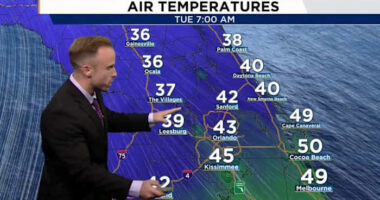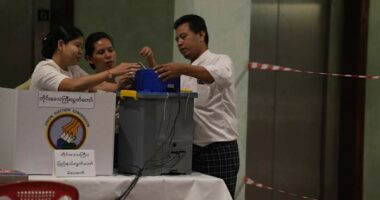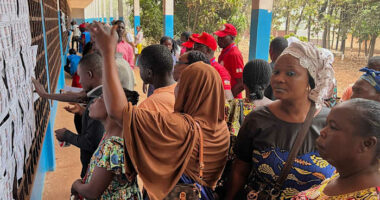Share this @internewscast.com

(The Hill) Advocates for public media on Capitol Hill and elsewhere are actively seeking solutions to avoid a looming financial crisis for public media following budget reductions initiated by President Trump and implemented by his supporters in Congress.
Bipartisan senators are committed to safeguarding local stations after Congress slashed funding for the Corporation for Public Broadcasting (CPB), a government-supported organization that has announced it will cease operations as a result.
Simultaneously, leaders in public media are exploring methods to mitigate the impact on vulnerable stations but have cautioned that bridging the financial shortfall might be nearly insurmountable.
“No one can substitute $600 million annually,” Tim Isgitt, CEO of the Public Media Company, stated on Tuesday. “CPB was the primary supporter of local news and information nationwide, and indeed, philanthropy alone cannot fill that void.”
Isgitt’s organization spearheads a philanthropic initiative, the Public Media Bridge Fund, which has successfully raised over $26 million to support stations at risk of closing due to the CPB funding reductions.
“For these threatened stations, CPB typically provides around $55 million annually, specifically to these 115 we’ve pinpointed,” Isgitt explained to The Hill. He mentioned the objective is to collect approximately $100 million over two years to help mitigate the shortfall for these stations, while also investigating ways for them to become “more sustainable over time,” which includes identifying alternative revenue sources or cutting costs.
In total, a group of philanthropic organizations including The Knight Foundation, Robert Wood Johnson Foundation and the Schmidt Family Foundation, all longtime backers of public media, pledged to commit nearly $37 million this week to provide immediate relief to public media stations at risk of closure following federal funding cuts.
“Local public media stations are trusted community anchors that connect people to vital news, culture and civic life,” Maribel Pérez Wadsworth, president and CEO of Knight Foundation said in a statement. “This is an urgent moment that calls for bold action.”
Public broadcasting stations have also seen a boost in donations in response to the cuts, with reports showing tens of millions of dollars in increased support in recent months.
But advocates for public media say much more is needed to fill a more than $500 million hole for the coming fiscal year. Some say the void left by the closure of local public media stations would pose a risk to public safety and quality of life, particularly in rural communities.
“Like many people, I learned to read and count because of public media. It’s the lifeblood of so many localities,” said Pete Loge, who teaches communications and media at George Washington University. “Trump is a really good big national theatre and spectacle … the irony is a move like this is made to seem like it’s attacking liberals, but it’s actually harming a lot of Republican constituents.”
The CPB said earlier this month it would begin an “orderly wind-down of its operations” after the GOP-led Congress approved about $1 billion in cuts to the corporation, or combined funding previously made available for the organization for fiscal years 2026 and 2027.
It also said this week that it “no longer can absorb costs and manage the Next Generation Warning System (NGWS) grant program” as a result of the cuts to its operating costs. CPB partnered with the Federal Emergency Management Agency (FEMA) to implement the program.
Congress currently has until Sept. 30 to pass legislation to keep the government funded into fiscal 2026, which begins Oct. 1, or risk its first government shutdown in years.
Some on Capitol Hill are hopeful that lawmakers could still pull out a bipartisan fix to protect local stations, mainly in rural areas, that rely on funding from the federal government to operate.
“I think that the discussion around their decisions really was focused on national programming and concerns that people had about NPR and PBS, and I think that really what got missed in that whole discussion was the impact that this rescission was going to have on local stations,” Kate Riley, the president and chief executive officer for America’s Public Television Stations (APTS), said.
“We’ve talked to a wide range of members, including many Republicans, who strongly support their local stations and recognize the essential role that their local stations provide in serving their community and their constituents, and are realizing now that this broad rescission has had some unintended consequences on their local stations,” Riley said.
Funding for CPB was notably excluded in the annual funding bill for the departments of Labor and Health and Human Services that was passed by the Senate Appropriations Committee last month. The CPB said it marked the first time in more than five decades the funding had been left out.
Sen. Tammy Baldwin (Wis.), the top Democrat on the subcommittee that crafts the annual funding bill, suggested funding for local stations could find bipartisan support in Congress, separate from the administration’s efforts to dismantle CPB.
“A priority for most of the Republicans who have announced their support or their opposition to defunding the Corporation for Public Broadcasting, is that they have many small rural stations” Baldwin told The Hill. “Their capacity to do private fundraising is very limited if you serve a very, you know, rural population with a small population, but they need it for emergency alerts and educational programming and local news. And so, I think that’s where we’re going to be able to come together.”
But for some stations, the time crunch is tighter. NPR said multiple stations began their fiscal 2026 budget in July. Isgitt also noted that November, when many public stations would typically receive funding from CPB, will also be a critical time for other outlets.
“I don’t know what cash flow or assets look like for every one of these stations, but you can be assured that, in the months after November, several stations will begin to fail, and then more will fail, and more will fail after that,” he said. “It’s going to happen. This is a cash-strapped industry.”
Republicans said they had worked out a deal with the administration aimed at helping shield tribal stations from the cuts by repurposing other funds for the effort. But Sen. Lisa Murkowski (R-Alaska), a senior appropriator, has raised questions about the funding and noted that many stations in her state, which has a significant indigenous population, could still fall through the cracks because they aren’t considered tribally-owned or serving tribal land.
“I have to figure out a way to maintain not just the tribal stations, because half of those stations are not tribal,” Murkowski told The Hill. “They’re pretty dang important, and so, yeah, I got to find a way. I don’t know what the path is, but I’m working on it.”
Native Public Media CEO Loris Tiller said the organization conducted a recent poll of 19 tribal stations so far that all said anywhere from 40-100 percent of their annual budget came from CPB funds.
“We also asked them whether staff layoffs will be necessary, and you can see that the majority of them are affirmative in that response,” Taylor said, while also adding she still doesn’t have many answers about the administration’s side deal with Senate Republicans to protect tribal stations.
“We just haven’t heard anything about that. I don’t know if it’s moving,” Taylor said. “I don’t know where the money’s coming from. The details haven’t been forthcoming.”
Advocates have also raised concerns about public stations at historically Black colleges and universities (HBCUs) they say are at risk in wake of the CPB cuts. About a dozen NPR members are affiliated with HBCUs.
Cuts to public media have long been on the wishlist of President Trump and conservatives more generally.
The president earlier this year sent a special request to Congress to secure the cuts without Democratic support. Upon passage of the legislation, Trump cheered the measure on social media for cutting “atrocious NPR and Public Broadcasting.”
Many Republicans in both chambers share the same view, often singling out NPR and PBS, which receive some funding from CPB, for what they allege is political bias.
About one percent of NPR’s current operating budget comes directly from the federal government, compared to 15 percent for PBS, multiple outlets report. In the previous fiscal year, NPR received upwards of $13 million from CPB, the corporation’s grants and allocations data shows. More than $70 million went to PBS, based in Arlington.
At a hearing on Capitol Hill earlier this year, the CEOs of NPR and PBS faced an intense grilling from angry lawmakers over their editorial decision making and funding models.
Other lawmakers have argued public media has been outpaced by major changes to the media ecosystem and the emergence of alternative news platforms.
“Because of technology today, I don’t think there’s a role for public radio anymore,” Rep. James Comer (R-Ky.) said during a House Oversight and Government Reform hearing in March.
In a statement after the Senate passed cuts to the CPB, PBS President and CEO Paula Kerger said the moves “goes against the will of the American people, the vast majority of whom trust PBS and believe we provide excellent value to their communities.”
“These cuts will significantly impact all of our stations, but will be especially devastating to smaller stations and those serving large rural areas,” she said. “Many of our stations which provide access to free unique local programming and emergency alerts will now be forced to make hard decisions in the weeks and months ahead.”











